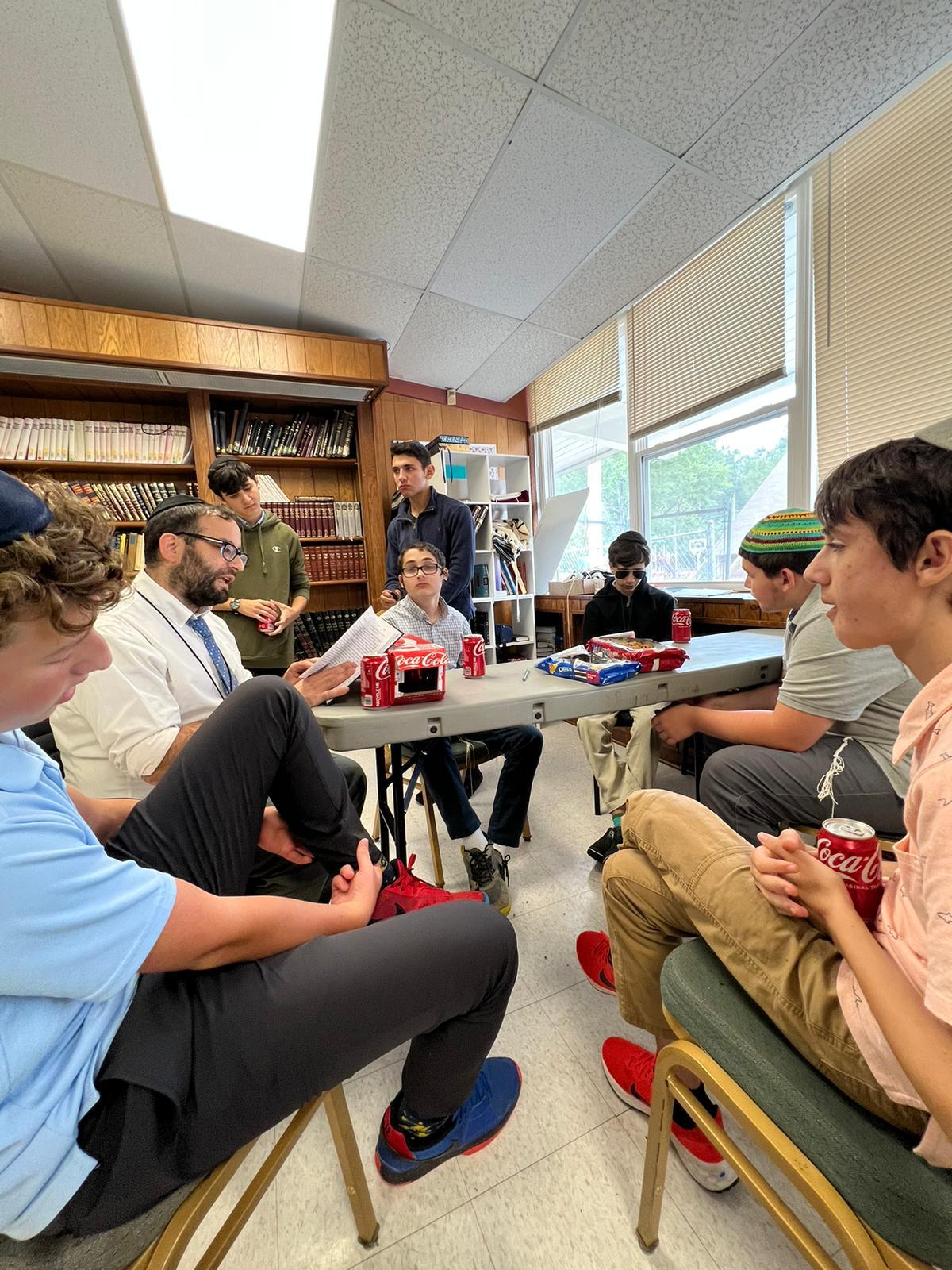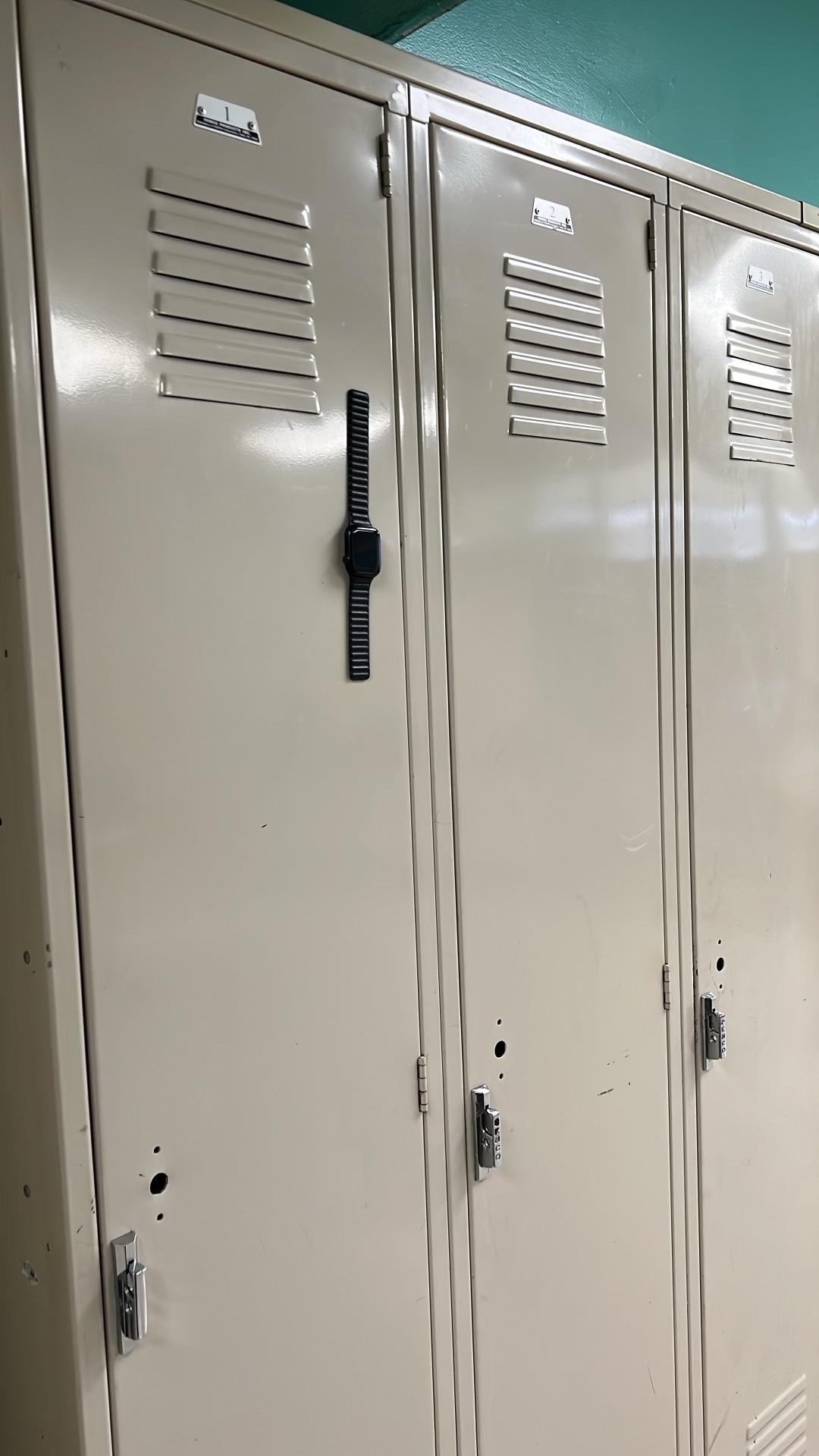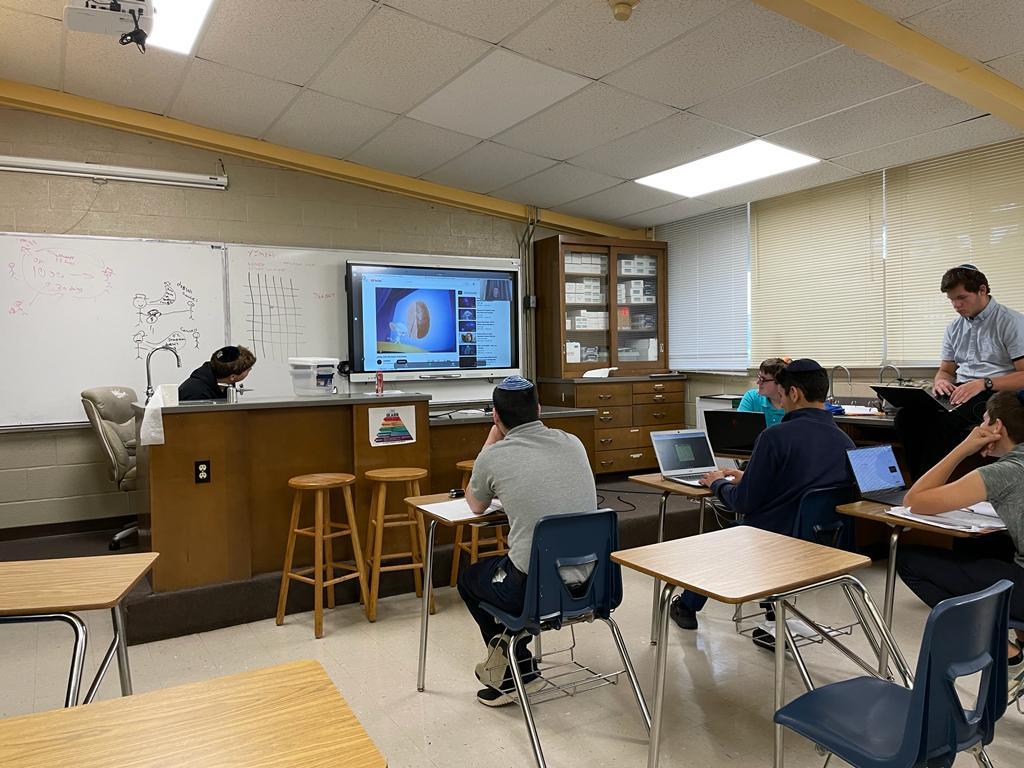CYHSB WEEKLY
Cooper Yeshiva High School for Boys
Volume 18, Issue 3
Pickleball: Passing Fad or Here to Stay?
Page 3
Cooper Clicks
Page 4
AP Classes: Worth all the Stress?
Page 5
Modern Day Heresy: Analyzing Rambam

Page 6
This week's issue is sponsored by Rabbi Noam and Dr. Deena Davidovics in honor of a great davening at the CYHSB. Reach out to Nadav Lowell at nadav.lowell@mhafyos.org in order to sponsor an issue and get your message out to the community.
Claustrophobic Conundrum: American Citizen Caught in Turkish Cave

Ilan Lennon (28’)
On August 31, 2023, Mark Dickey was trapped over 3,600 feet below the surface in the Morca Cave in Turkey after falling ill from what is thought to be gastrointestinal bleeding. Dickey was part of a research team in Morca Valley mapping the third deepest cave in Turkey, at 4,186 feet deep. The 40 year old American caver was hoping to map another pathway. Ironically, Dickey has been an instructor with the US National Cave Rescue Commission for 10
years, teaching a variety of cave rescue classes. (CNN)
For anyone on the outside, our first thoughts would be to get him out rather than plan ahead, and acquire the daily necessities inside the cave; however, food, water, medicine and blood were still required in order for Dickey to receive the intensive medical care he needed. Although he was visibly healthy after beginning to receive treatment, there was still much work to be done internally. Mr. Dickey stated in a video, “As you
Volume 18, Issue 3 September 15, 2023 CYHSB Weekly 1
Trapped American is saved by rescuer from his dangerous situation stuck in a cave. Source: reuters.com
Cont. from last page: can see, I’m up, I’m alert, I’m talking, but I’m not healed on the inside yet, so I’m going to need a lot of help to get out of here.” He said that before medical help arrived, he had felt “very close to the edge.”

Luckily, Dickey was with another person, who managed to get him to the closest cave base camp, located a little over 3,400 feet deep. He remained there until he was rescued by a crew of over 200 people, to whom he wanted “to thank everyone that’s down here.” The rescuers began moving Dickey up the cave on Saturday, September 9 in the afternoon The teams had to navigate narrow passages, install communications systems, and blast open narrow areas so they could move Dickey through on a stretcher. It wasn’t until the twelfth day of being underground that Dickey finally saw the sun again and got to see his parents, which he may have thought would never happen again; they felt the same gratitude that he felt and expressed it to the rescuers, “It is, we know, an event that all involved in the extensive rescue effort worked so significantly hard for,” they said. “Mark is strong and we believe in his
strength, but fully knew that he was in dire need of tremendous and immediate support. We are so very thankful and grateful that the support he needed was given to him and that the first medical rescue team to arrive reached him when they did.”
Dickey credits his rescue to his fiancee, Jessica Van Ord, who
This portrays a mindset that the CYHSB instills in all of its studentsleading by example in helping community members, whether they are in great need or as small as providing a classmate with encouraging compliments to get them through the day.

Dickey himself said that caving and cave rescues often present "a great opportunity to show just how well the international world can work together." With more than 180 rescuers from across eight countries who had been on hand to help get him back into daylight, his sentiment appeared well-founded.
climbed nearly 3,300 feet to retrieve the fluids necessary for his survival, and to the Turkish government. "It was the rapid response of the Turkish government that got the resources to her," he said. "Saved my life." If it wasn’t for the care and pure kindness of these many people, many of whom risked their lives, he may not have survived.
Kindness can bring about different sides of a person. While we are taught from a young age that bad actions have consequences, so do good actions. One action will lead to another no matter the intent. If enough people do this enough good-hearted actions, world peace is something that is inevitable. As the Torah states, “Mitzvah Goreret Mitzvah,” which means one good deed will lead to another. With an unfortunate event that brought more than 180 people from eight separate countries to help rescue him, this scary event may have been for the good.
Volume 18, Issue 3 September 15, 2023 CYHSB Weekly 2
CALVIN AND HOBBES © Watterson. Reprinted with permission of ANDREWS MCMEEL SYNDICATION. All rights reserved.
American man trapped in Turkish cave. Source: people.com
Pickleball: Passing Fad or Here to Stay?
Amit Zalman (’27) Pickleball is a recreational sport that has rapidly gained popularity across the United States. Developed in 1965, this unique combination of badminton, ping-pong, and tennis has become a beloved pastime for people of all ages, including students at the CYHSB. It's easy to learn, fosters competitiveness and socialization, and provides a form of low-impact exercise. However, as with any sport, there are inherent risks involved.
Pickleball was born out of creativity when former Washington state congressman Joel Pritchard and a friend couldn't find all the equipment needed for badminton. Using wooden ping-pong paddles and a perforated plastic ball, they played on an improvised court with a badminton net set at a tennis-like height. The game quickly evolved, and within a few years, it had its first permanent court.
ball with holes, similar in size to a Wiffle ball, over the net using a racket that falls in size between a ping-pong paddle and a tennis racket. The serving is underhand, and the receiving opponent returns the ball within bounds but outside the no-volley zone. The game continues until a fault occurs, and points are scored only by the serving team.

pounding on the hard court surface. These include conditions like plantar fasciitis, heel contusions, muscle strains in the lower extremities, and lumbar muscle strains.
Proper equipment and injury prevention measures can significantly reduce the risk of injuries in pickleball. Proper-fitting shoes with good lateral stability are crucial. Ankle braces with laces and/or straps can help those with chronic ankle issues, while lightweight knee braces may provide added comfort and stability for those with knee problems. Additionally, regular cardiovascular exercise outside of pickleball can reduce fatigue associated with play. The U.S. Office of Disease Prevention and Health Promotion recommends 150 minutes of moderate-intensity aerobic physical activity per week.
Last Week’s Solution
Fast forward to today, and pickleball is experiencing explosive growth. In 2017, the Sports & Fitness Industry Association estimated that over 2.8 million people in the U.S. played pickleball, marking a 12.3% increase from the previous year. The sport's appeal transcends age, with many older adults relishing the competitiveness and socialization it offers.
Pickleball can be played indoors or outdoors on a smaller court compared to tennis. The court measures 20 ft. by 44 ft., with a net height of 34 inches at the center. Similar to tennis, it can be played as singles or doubles. One unique feature is the seven-foot no-volley zone on each side of the net.The game involves hitting a hard plastic
While there is limited published research specifically on pickleball injuries, we can draw insights from similar racket sports like tennis. In tennis, common injuries include sprains/strains of the lower and upper extremities and injuries to the trunk and lower back.
Pickleball's underhand nature reduces the risk of shoulder injuries compared to tennis, where overhand serving is prevalent. However, other upper extremity injuries are possible. Acute traumatic injuries often result from falls, such as ankle sprains, Achilles tendon strains, and knee injuries. Chronic injuries can arise from overuse or repetitive
Pickleball is a beloved sport that promotes physical activity and socialization. While it carries some risk of injury, proper preparation, awareness of personal health conditions, and preventive measures can make it a safe and enjoyable activity for players of all ages. In fact, pickleball has even risen to popularity in our school. Senior Yosef VanderWalde says, “It’s a fun game to play after school with my fellow friends. I can really see myself playing more.”
As the sport continues to grow, it's essential for players to prioritize their safety, wear appropriate gear, and consider their physical limitations. By doing so, pickleball enthusiasts can continue to enjoy this unique and engaging sport while minimizing the risks associated with it.
Volume 18, Issue 3 September 15, 2023 CYHSB Weekly 3
Picklebal is one of the fastest growing sports in America, and is developing a sort of cult folowing. Source: usapicklebal.org






Volume 18, Issue 3 September 15, 2023 CYHSB Weekly 4 Cooper Clicks Radical Riddles What can be held in your left hand but not in your right hand? Send your answer to amit.zalman@mhafyos.org. First one to submit an answer wins a prize. Last week's answer: Flax
Top Right: Watch? Top Left: In a secret, windowless, basement of the boy's highschool, many students hide from the teachers and try to skip class. Bottom Right: The Golf team has a celebrity encounter at their recent golf practice. Bottom Left: Rabbi Hollanders and friends have show and tell. Photos by Jack Kampf and JJ Stein.
AP Classes: Worth all the Stress?
Raanan Vanderwalde (’25)
In our school, there are classes that are offered to the students looking for an advanced version of the normal routine classes. Advanced Placements (AP) are the most difficult classes that someone can take in high school. Designed by the College Board, these classes are meant to give high schoolers a taste of what college classes are like. At the end of the year, the College Board designs an exam for each specific AP class, which is graded on a scale of 1-5. Scores over 3 can count towards college credit depending on which college you decide to attend. This year, the school is offering five different APs to the students who are interested in rigorous yet rewarding coursework.
AP Psychology:
Last Week’s Solution
This AP is during the elective period and is the only one that is offered to sophomores along with the upperclassmen. The subject matter of AP Psychology is mainly learning about how the brain functions and how humans think. “I am thrilled to immerse myself in psychological concepts that will expand my understanding of the intricacies of the human brain and its functions," said sophomore Akiva Levine. The class is taught by Mr. McCann.
AP Language:
This class rotates with AP Literature every year. Much of AP Language is focused on the use of rhetoric, or persuasive language, in literature and other areas. The class is taught by Mrs. Brown. Junior Ilan Lowell, who is taking the course, said about AP Language: “I am excited to learn how to improve and add new techniques to my writing." Many other students would agree.

AP US History:
This AP is widely regarded as one of the hardest APs due to its low pass rates (only 26% of students get
a four or a five according to collegeboard.org). AP US History is a class that covers all of US History from Pre Columbian American societies all the way through the 21st century. The class is taught by our general studies principal, Dr. Kennon. Ezra Davidovics, a senior taking AP US History, said, “I really like APUSH so far and am excited to see what we’ll learn the rest of the year.”
AP Calculus:
In high school, the honors course of math, which begins in 9th grade, is in preparation to eventually take Calculus in 12th grade. Calculus is the highest math offered in our school and is only available to those who took Pre Calculus the year prior. Therefore, the class is almost always a course just for seniors. Calculus is offered every year at our school and is taught by Mr. McCann. Yaron Weiss, a senior taking Calculus said, “Calculus is challenging but Mr McCann does a great job helping us get through it.”
AP Physics 1:
Filling in as the advanced science class, AP Physics 1 is offered to both 11th and 12th graders. This AP

is often said to be the hardest AP course there is. One of the reasons for the difficulty of the course is that this AP has the highest fail rate with 55% of students getting either a two or one on the final exam, according to collegeboard.org. However, despite the challenges, a handful of students have taken it upon themselves to take this course. Ethan VanderWalde, a Junior taking AP Physics 1 said, “It’s definitely challenging, but it will hopefully be rewarding as I keep trying to conquer new concepts that I’ve never been exposed to before.” The content of AP Physics 1 is mainly algebra based physics such as forces and simple motion along with a handful of other topics. This course is being taught by Dr. Maxwell Shapiro, a mathematics instructor at our school.
As our APs start, many students are excited, but the majority are probably scared. I would like to wish good luck to all AP students this year and I hope that everyone does well.
Volume 18, Issue 3 September 15, 2023 CYHSB Weekly 5
AP Psych enjoys a video about the parts of the brain. Photo: J.J. Stein
Modern Day Heresy: Analyzing Rambam
Avi Becker (’24)
Last Week’s Solution
Judaism is a constantly developing religion. As members attempt to prove their legitimacy to other sects, they are asked to what extent they keep the commandments. They are eventually confronted with the eternal question: What’s considered faith? What is the threshold? Does the Torah merely demand actions, the 613 mitzvot as well as moral and ethical behavior, or does it too demand belief? We know G-d is fair: “He is the Rock, His work is perfect; for all His ways are just. A G-d of faithfulness without injustice; just and straight is He” (Deuteronomy 32:4). The notion of justice poses a major problem that has been around for centuries if not millenia: how can G-d expect us to believe, and hold us accountable if we don’t, if, presumably, belief is not in our control. A person can will himself to act; but can he will himself to believe? Even if he could, if he doesn’t believe why would he? Rambam, as well as many other Rishonim, posit that belief in G-d is in itself insufficient; one must believe in all of the basic Jewish principles of faith in order to experience Olam Haba. One of these beliefs, divine incorporeality, is sufficiently unintuitive that large swaths of the Jewish people, in Rambam’s time, didn’t fully accept it. The masses of Jewish corporealists throughout history were not malicious, they simply didn’t know better or were misled by the biblical and rabbinic texts that, superficially understood, suggest divine materiality. Why, then, were they culpable? How is Rambam’s position compatible with divine justice? Are we really expected to believe in that which is not clearly stated? How can the Torah itself lead us astray while simultaneously commanding us to not lead others astray? For example, the Torah posits the concept of “An eye for an eye” yet in the Gemara’s
discussion it reasons that an eye means money.
After listing the thirteen principles of faith in his Introduction to Perek Chelek, the 10th chapter of tractate Sanhedrin, Rambam writes: “And when a person believes all these fundamentals and his faith in them will be genuine, he enters into the nation of Israel, and it is a mitzvah to love him, have mercy upon him, and act towards him according to all the ways G-d commanded us regarding love and brotherliness. And even if he did all of the sins in the Torah due to desire of the emotions and from his evil inclination conquering him, he will be punished for his sins, but he still has a share in the world to come and is among the sinners of Israel. If, however, he doubts one of these fundamentals, he has left the nation and has denied the fundamentals and is called a heretic, a denier, etc., and it is a mitzvah to hate him and to destroy him. And regarding him it is said, “Behold, will not the enemy of G-d be my enemy?” (Psalms 139:21).”

As to say that anyone who does not conform is sentenced to exclusion from this eternity. This seems to be regardless of the circumstances. One of the classical understandings of Rambam, attributed in part to R. Chaim Soloveitchik, is that with respect to basic tenets of belief, it does not matter whether someone’s error is innocent. True, a person may be blameless; however, when it comes to false conceptions of G-d, an innocent heretic is also deemed a heretic.
But why consider the accidental heretic a heretic? The likely rationale for this thesis is that in Rambam’s view belief in a corporeal G-d does not constitute belief in G-d whatsoever, because such a G-d does not exist. Thus, like the idolater, the corporealist prays to and worships a figment of his own imagination. Rambam deems such a
person an accidental heretic insofar as he thinks that he believes in G-d while, in fact, he does not. In fact, the deity he believes in has nothing to do with G-d due to the centrality of incorporeality in defining G-d. It is like a child believing that a square is a circle, as far as the attempt goes, he might not be far, but false conceptions still command consequences.
Still, one may object, it is not his fault. Why should he be punished? The answer, according to this view, is that Rambam maintains that the soul achieves immortality through the knowledge of non-physical beings garnered in this world. As such, a correct conception of G-d is a natural and necessary prerequisite to achieving Olam Haba. Thus, the loss of Olam Haba is not a punishment, which would be unfair, but rather a natural consequence. Hilchot Yesodei ha-Torah 4:8-9 and Hilchot Teshuvah 8:2-3. Abarbanel, Rosh Amana Ch. 12 appears to adopt this first approach to understanding Rambam’s view. He explains with an analogy. Just as someone who swallows poison thinking that it is food inevitably will be harmed despite not deserving it, so too the
Volume 18, Issue 3 September 15 2023 CYHSB Weekly 6
The Rambam. Source Wikipedia.com
Cont. from last page, natural consequence of disbelief is to not partake in immortality. But can’t G-d override this natural consequence for the sake of man's eternity?
Last Week’s Solution
One problem with this first position emerges from another innovative ruling of Rambam. The Talmud (Shabbat 68b) introduces the concept of tinok she-nishba bein hanochrim (an infant who was captured and consequently raised among gentiles) regarding the number of sacrifices the individual would bring for violating the Sabbath since he didn’t know any better. Rambam (Hilchot Mamerim 3:3 and elsewhere) extends the tinok she-nishba principle to matters that relate to the thirteen principles of faith. This seems to be a direct reference to the Stira he creates. For example, Rambam maintains that a person who does not acknowledge the validity of the oral law is deemed a heretic and punished accordingly. However, this is true only if he “denied the oral law consciously, according to his perception of things,” such as the first generation of Karaites. The “children of these errant people and their grandchildren whose parents led them away and those who were born among these Karaites and raised according to their conception are considered as children captured and raised by them.” Since they are not responsible for their false beliefs, the legal consequences of heresy are not applied to them. So in the modern age with our “modern Karaites” should this not apply?

Even though the second-generation Karaite denies one of the thirteen principles by rejecting the authority of the Oral Law, he is not treated as a heretic because he is not held responsible for his false beliefs; he simply was falsely educated from youth. This seems to contradict the assumption of the first approach that we classify a person as a heretic even if it is not his fault.
Why then does Rambam hold the corporealist responsible? Why don’t
we apply the tinok she-nishba principle to one who misinterpreted scripture and concluded that G-d has a body? A very reasonable assumption when taking into account how many times we reference G-d’s “Yad” (Pesach). This
ought to know that an idolater is similarly impelled to his idolatry by imaginings and defective representations. Accordingly, there is no excuse for one who does not accept the experts (the true philosophers) if he himself is incapable of engaging in such speculation. I do not consider those men as heretics who are unable to prove incorporeality, but I hold those to be people who do not believe it, especially when they see that Targum Onkelos and Targum Yonatan avoid [in reference to G-d] expressions implying corporeality as much as possible. As if to say, he’s not punished for the misconceptions but rather for the lack of knowledge that he could have attained, which is the main difference between the two answers.
brings us to the second approach to understanding Rambam’s view on accidental heresy. Rambam actually addresses the question of why we don’t excuse the corporealist in I:36 of The Guide for the Perplexed (Moreh ha-Nevuchim) writing that if we were to excuse those who believe in a corporeal G-d, we ought to excuse idolaters as well since, in both cases, the error emerges from faulty comprehension or faulty education.
If you think that there is an excuse for those who believe in the corporeality of G-d on the grounds of their training, their ignorance, or their defective comprehension, you must make the same concession to the worshippers of idols. Their worship is due to ignorance or childhood training; “They continue in the custom of their fathers” (Chullin 13a).
If, however, you should say that the literal interpretation of Scripture causes men to corporealize G-d, you
In other words: Rambam argues that the reason these heretics have no excuse is that they should have accepted the position of the experts (the true philosophers) if they were unable to independently ascertain the truth. Rambam forcefully implies that the person is responsible insofar as he fails to utilize the tools available to him. Rambam assumes that a person is capable of being aware of his own limitations. However, if these tools are not available, then to some degree, the errors are excusable. Rambam’s answer does not seem to correspond to the assumption made in the first approach that such a person’s exclusion from the next world is a natural consequence. If the first approach was correct Rambam should have responded that Olam Haba is by definition impossible for someone with an incorrect conception of G-d. Instead, Rambam answers that the person is in fact to blame for his erroneous beliefs. The implication is that he is considered a heretic because of his negligence. Thus, Rambam appears to distinguish between the secondgeneration Karaite who is blameless and therefore excused, and the corporealist who is negligent and therefore culpable.
Volume 18, Issue 3 September 15 2023 CYHSB Weekly 7
The Title page of Moreh Nevuchim. Source Wikipidea.com
Good Shabbos!
CYHSB Weekly Staff
Editor-in-Chief
Ezra Davidovics | ezra.davidovics@mhafyos.org
Associate Editor-in-Chief
Nadav Lowell | nadav.lowell@mhafyos.org
Managing Editor
Raanan Vanderwalde | raanan.vanderwalde@mhafyos.org
Head of Torah Affairs


Avi Becker | avi.becker@mhafyos.org
Assistant Layout Editors
Amit Zalman | amit.zalman@mhafyos.org
Rafi Davidovics | rafael.davidovics@mhafyos.org
News Editors
Joshua Parcover | joshua.parcover@mhafyos.org
Yaron Weiss | yaron.weiss@mhafyos.org
Akiva Levine | akiva.levine@mhafyos.org
Photographers and Complaint Managers
J.J. Stein | jacob.stein@mhafyos.org
Jack Kampf | jack.kampf@mhafyos.org
CYHSB Weekly Staff
Jojo Ardestani | jonathan.ardestani@mhafyos.org
Rafi Goldkin | rafael.goldkin@mhafyos.org
Benny Freiden | benjamin.freiden@mhafyos.org
Ilan Lennon | ilan.lennon@mhafyos.org
Jonah Siegel | jonah.siegel@mhafyos.org
Omer Zalman | omer.zalman@mhafyos.org
Avigdor Zweihorn | avigdor.zweihorn@mhafyos.org
Davi Baum | david.baum@mhafyos.org
Administrative Advisors
Rabbi Dov Rossman
Mrs. Ashley Brown
From the Editor:
Whether it’s deciding which AP classes to take, or what sport to play decisions are a constant part of our lives. Some decisions can feel insignificant in the moment, but they may have long-lasting consequences. These consequences can range from getting trapped in a cave, to being cut off from eternal reward. Let’s all try to make better decisions and always make good choices.
- Ezra Davidovics
Volume 18, Issue 3 September 15, 2023 CYHSB Weekly 8
Wishing everyone a הָבוט הָמיִתֲחְו הָביִתְכ and a sweet new year!

















